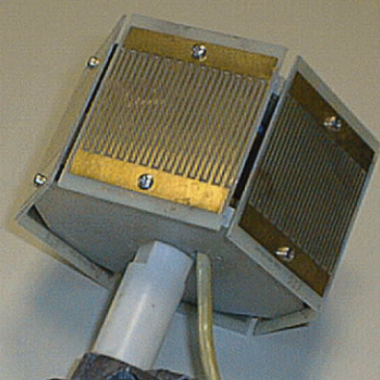
What is and what is used for
The presence of water on leaves is due to either rain or dew that forms by condensation of the atmospheric humidity, that is when the leaf surface temperature is lower than the water dew temperature. The principle of operation of the leaf wetting sensor is based on the measurement of the value of resistance between two gold-plated copper combs on a fibreglass plate 65.5x80 mm in size (size of the artificial leaf). When there is even a minimum layer of water on the surface of the plate, conductivity is maximum and the electronic circuit associated with the sensor gives the “wet leaf” state in output; on the contrary, conductivity is practically nil if the leaf is dry.Construction
The LW6 leaf wetting sensor consists of six variously oriented measurement surfaces. The important role that leaf wetting plays in the onset and development of some plant diseases is well known, so using the sensor is essential for any station whose objective is to survey the phytosanitary conditions of the crops.Main features
- Easy maintenance: the sensor needs no particular maintenance work; it is only advisable to periodically clean the printed circuit plates with a cotton wad soaked in water.
- Sturdy and reliable construction: lastly makes it an instrument with a long lifetime, which safeguards the customer’s investment.
- Components that can be added or be built into the product: to perform complete monitoring for phytosanitary prevention purposes, it is recommended to install the sensor combined with the R102 pluviometric sensor, the SHN thermohygrometric sensor, the CM6B radiometric sensor and the WS50F, WDA and WSG wind sensors.
Materials to download
Technical Data Sheet